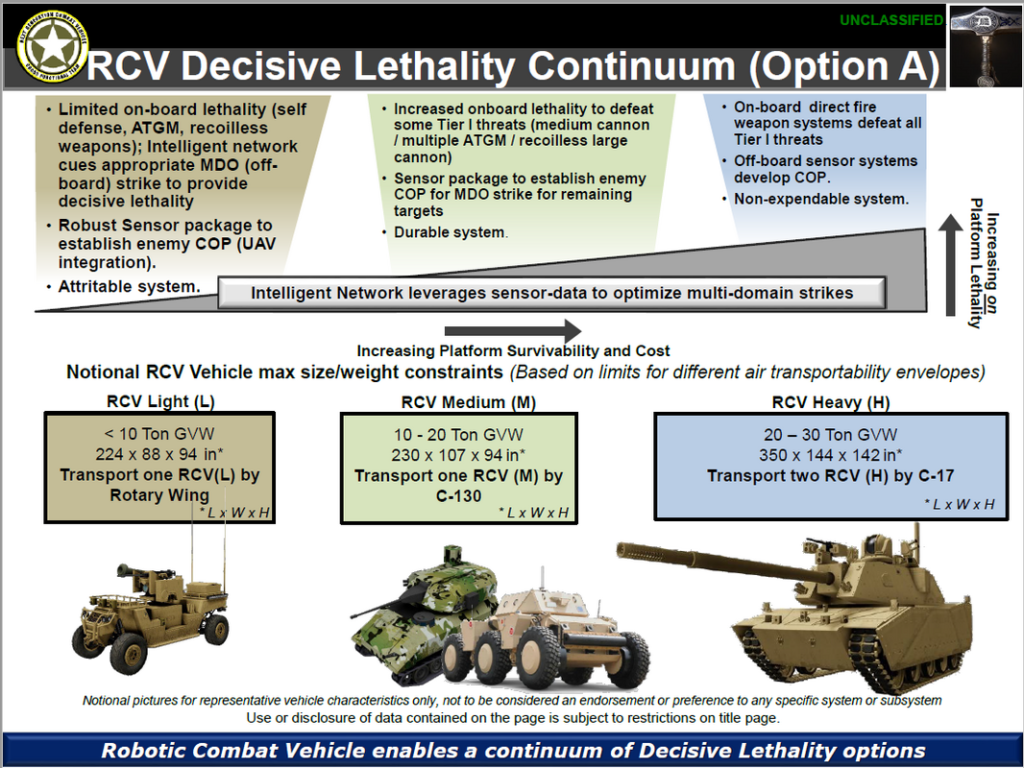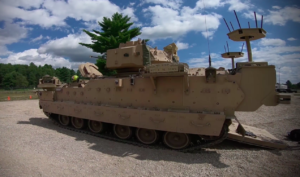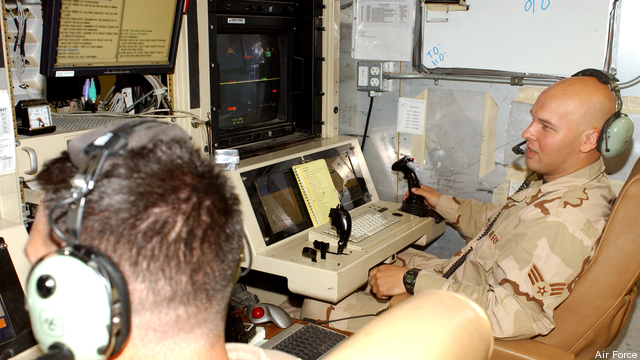Army Robots Go Rolling Along – Ahead Of Schedule
Posted on
WASHINGTON: One of the Army’s most ambitious weapons programs, remote-controlled Robotic Combat Vehicles, is actually ahead of schedule, the Army’s chief of armored vehicle modernization says. A lot of that robotic technology will be on display at the massive AUSA 2019 trade show here.
“There’s a lot of excitement in industry, in the Army, and we’ve seen industry ahead of our timeline a little bit,” Brig. Gen. Richard Ross Coffman, director of the Next Generation Combat Vehicle Cross Functional Team, told me Friday. “We are adjusting our expectations.”

Brig. Gen. Richard Ross Coffman
Specifically, Coffman said, he was impressed by the levels of autonomy – much of it derived from civilian work on self-driving cars – and of modularity – that is, the ability to swap different sensors, weapons, and other systems to tailor the robots for different Army missions. Overall, the robots are about two years more sophisticated than expected, he said. Capabilities the service expected in 2023 are now potentially achievable in 2021.
Now, this is not the kind of news you expect to hear when a high-tech military program moves from the idea stage to checking out proto-prototype equipment. The Army in particular blew nearly $20 billion on the Future Combat Systems, a complex assembly of manned vehicles, ground robots, drones, and more that was cancelled in 2009 because the technology just wasn’t ready.
In contrast, the Army has already field-tested software and tactics using modified M113s – an obsolete armored transport – and checked out eight new robots for the Robotic Combat Vehicle from six private-sector teams during a week of demonstrations at Texas A&M’s RELLIS research campus in May. Coming up, the service plans three years of increasingly complex field experiments, with real soldiers controlling real robots, to test RCV concepts and technology before deciding whether to commit to a full-scale acquisition program.
“Everything is on the table. We are learning, we are prototyping, and we’ve established decision points for Army senior leaders,” Coffman said. “Those decision points are going to allow Army senior leaders to make decisions on what we field, and when, and with what capabilities.”

Four Years, Three Phases, Three Weight Classes
“It’s ’20, ’21, and ’23,” Coffman explained:
- 2020 – Phase I: Starting in March, a platoon of four unmanned M113s, remote-controlled by soldiers in modified M2 Bradley vehicles called MET-Ds (as seen in the Army video above), will go through a month of field tests at Fort Carson.
- 2021 – Phase II: Army soldiers – still using the modified Bradleys as control vehicles — will start testing new robots from industry. There’ll be a mix of four prototype RCV-Light unmanned vehicles, weighing 10 tons or less and capable of carrying infantry weapons like machineguns or Javelin anti-tank missiles, and four RCV-Medium ’bots, weighing up to 12 tons and capable of mounting, say, a 30 mm chaingun. Combined with six of the modified M113s, that will form a full company of robots, allowing trials of much more complex tactics.
- 2023 – Phase III: Soldiers will test an upgraded company of robots, including the first four RCV-Heavy vehicles. These will be, effectively, unmanned light tanks weighing roughly 20 tons that could potentially carry a 120-mm cannon. Now, even the “heavy” robot is nowhere near as heavy as a massively armored M1 Abrams tank, which weighs 60 to 70 tons. But Coffman argues they don’t have to be, because they don’t have humans inside them to protect.
Originally, Coffman told me, the Army expected the industry-built robots in the 2021 experiment would be modified models of whatever companies had “on the shelf.” Robots purpose-built for the RCV missions would take until 2023 – or so the Army thought. Based on what he’s seen so far, Coffman now expects those purpose-built robots to be ready in ’21.

An M2 Bradley troop carrier modified to carry the remote-control stations for unmanned vehicles.
Even the unmanned M113s are surprisingly capable, Coffman said. At Camp Grayling, Michigan, he said, “I witnessed four robots execute a maneuver, establish a screen line, call for [artillery] fire, and then attack, with direct fire, an opposing force – all while the control vehicles were under defilade and undetectable by the enemy.”
There are intriguing tactical possibilities when you can send expendable robots ahead into harm’s way while their human masters stay under cover. The bots could act as expendable decoys to draw enemy fire, for example, or emit smoke to cover the manned forces’ advance. Even relatively primitive remote-controlled machines can scout ahead for danger – whether enemy tanks or nuclear, biological, and chemical contamination (NBC) – or plow minefields and breach roadblocks.
“I think we can do NBC reconnaissance today,” Coffman told me. “I think we can do aspects of a combined arms breach, as they just demonstrated a few months ago out at Yakima. And I think we can deliver sensors, both day and night sensors, to detect enemy forces. We could execute a lethality option” – that is, robots armed with weapons that they may be able to aim autonomously, but which only fire on human command.
“All of those capabilities are available today,” he told me. “It’s at what range and at what cognitive burden to the controllers.”

A Predator ground control station. The drone requires two human crew to operate it by remote control, a pilot and a sensor/weapons specialist.
From Remote Control To True Autonomy
Commercial research into self-driving cars is spinning off lots of useful advances in software and sensors that the military can use, Coffman said, but it’s all optimized for travel on smooth, paved surfaces with clear curbs, stoplights, and traffic signs. By contrast, “off-road autonomy is really, really hard,” he told me. “There’s just a lot of perception and quick decisions that need to be made as you’re traversing broken terrain, and the machine is not there yet.”
“It takes about nine years to train a staff sergeant to maneuver a combat vehicle correctly over terrain, so he or she doesn’t show the underbelly of their vehicle to the enemy, doesn’t drive over the top of the ridge line, and uses the terrain to conceal the vehicle,” said Coffman, a veteran tanker himself. “If you see an M1 tanker maneuver that tank properly over the desert or a wooded area, it’s a thing of beauty … flowing like water over the battlefield.”
“These are things that we want the robots to be able to eventually do,” Coffman said. “I don’t think we’re going to get there — to where a machine is going to be as good as a human — probably till 2035 or beyond.”
For now, ground robots must be remote-controlled by skilled humans, like an early model Predator drone. What’s more, that control link must function even more reliably than is required for unmanned flight.

An M2 Bradly traverses piles of rubble in Iraq.
“If I’ve got an airborne asset flying at 10,000 feet, and I lose connectivity for a half a second, it’s still flying at 10,000 feet, and I’ve cleared that airspace, and I’m okay,” Coffman said. “On the ground, we need more constant feedback because obstacles are constant.”
Because it’s so much harder to navigate over rough terrain than through the empty air, ground robots today are where aerial drones were roughly 20 years ago. Just as the Predator requires two humans for remote control, one to fly and the other to operate sensors and weapons, each proto-prototype Robotic Combat Vehicle requires a driver and a gunner/sensor operator.
“I would like to get one controller to 12 robots,” Coffman said, “and we are a long way off from that – again, 2035 or beyond.”
For now, the need for an uninterrupted high-bandwidth connection is a vulnerability – since enemies could detect, jam, or hack it – and a limiting factor on how far ahead the robots can go.
“It’s a physics problem. We are working through it,” he told me. “We found some techniques — that I’m not going to tell you — that can extend our ranges further than our enemies’.”
“Let’s say we can only go four kilometers. That’s a long way,” Coffman said, enough to keep the human controls out of range of enemy tanks engaging the robots. “Two kilometers is a long way.”
“Anywhere that a soldier is at the highest risk on the battlefield, and we can replace him or her with a robot, that’s what we want to do,” Coffman said.
Subscribe to our newsletter
Promotions, new products and sales. Directly to your inbox.
